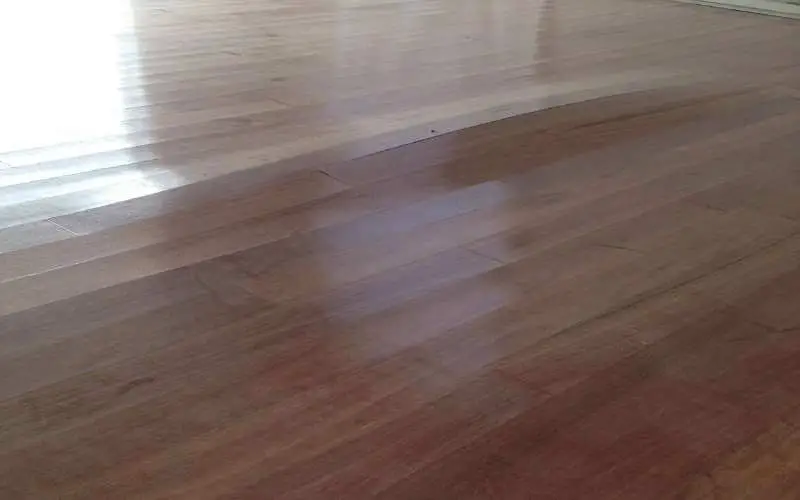Wood floor is a durable flooring option but can become damaged in various ways. Fixing common damages like small scratches and scrapes is very easy, and they can be easily buffed out.
But you would need to employ ways on how to fix swollen wood floor when you notice areas or edges of the floorboards lifting up or an unsightly hump in the center of the board.
This is usually caused by the expansion or contraction of the wood planks. If your wood floor is swollen or shows signs of buckling, you would need to take action and repair the damage.
Start by accessing the extent of the damage so you can determine the right approach; depending on the extent of the damage; you may not need to replace the floorboards.
How to Fix Swollen Wood Floor
Table of Contents
1. Assess the Swelling
Before you jump into action, inspect the visible damage on your hardwood floors, and see how badly the wood planks were affected by the water infiltration or moisture.
Determine the source of the moisture and seal it off completely. Fix the point of the water infiltration before taking action on the flooring.
Inspect the damage on the floorboard and see if the wood looks swollen, buckled, or has any sign of mold and mildew.
If your wood floor shows any signs of mold, it should be eradicated before proceeding to any other steps. This helps to maintain the quality of your flooring and prevent the spreading of mold.
After taking care of the mold, fix any leak, and you can proceed to fix the swollen wood floor.
2. Regulate the Room’s Temperature
Maintaining the right temperature is extremely important in controlling the buckling or swelling of your wood floor.
If your wood floor is swollen from high humidity, place ventilation fans to dry out the room. You can also set up a dehumidifier to hasten the drying process of the flooring and remove the moisture.
However, keep in mind that the drying process isn’t very quick. Getting your wood floor completely dry can take a very long time; this depends on the state of your wood floor and how humid they are.
It may take several months before your wood planks return to normal and becomes free of all traces of humidity.
Related: How to dry water under wood floor
3. Make Needed Repairs
Your wood floor may receive some permanent damages when it swells or buckles. After controlling and regulating the temperature in the room, the flooring may return to its original state.
If it does, you can decide to refinish the floor to give it a new and glossy look. This also helps in maintaining the good condition of the floor and prevents it from becoming swollen again.
Before making any repair on the wood plank, ensure all the moisture has disappeared, and you can use heat to dry out the wood. This enables you to properly assess the wood and determine if they need to be fixed and the right way to do so.
If the wood planks received extensive moisture damage and have split or even come apart from the tongue and groove fixing used in installing it to the floor, you would need to replace the boards.
Your swollen floorboards could split, especially if the wood has been sitting in a humid state for too long; complete replacement is the best fix for these boards.
You can replace the boards yourself if you have the expertise and needed tools; if not, it may be best to hire a professional who will access the situation and offer the best solution.
Why Is My Wooden Floor Swelling
You must be wondering, “why is my wooden floor swelling?” Well, here a two of the factors that can cause your wood floor to swell
1. Water Damage
This is the primary cause of swelling on wooden floors. If your floor is accidentally flooded with large amounts of water or moisture is allowed to build up over time, it puts your wooden floor at risk of swelling.
Moisture can build up from repeated small spills, especially if they’re not immediately cleaned up; it can also build up from the natural rise and fall of humidity levels.
It may take a while for you to notice the accumulation of moisture as it builds up gradually, and you may not notice a sign of a problem until it has done a lot of damage to your floorboards. Excess moisture causes the wooden floorboards to expand, contract, and lift.
2. Improper Installation
If your wooden flooring was not properly installed, your floor could buckle and swell. The use of insufficient glue, incorrect nailing, or inferior subfloor construction is all causative factors of buckling and swelling.
This can start as quickly as a few days after installation. To achieve a properly-installed wood floor, it is recommended to leave the job for professional wood floor experts, except you are an expert yourself.
Related: How to install hardwood floors
Conclusion
Before you begin the process to fix a swollen wood floor, start by accessing the extent of the damage, what physical damages are present on the board surface.
Depending on how badly the floorboards are, you can determine the right approach, and you may not need to replace the floorboards.

